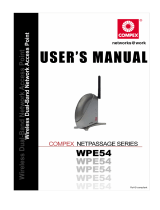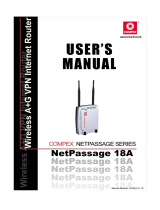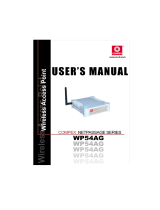Page is loading ...

NetShair Link (PC/Laptop)
NetShair Link Setup (Laptop/PC)
1. Turn on the NetShair Link by sliding the switch to “AP ON”.
2. Click on the wireless icon on the bottom right corner of the screen.
3. Choose the “NetShair LinkXXXX” Network.
4. Enter the default password “12345678” and then press “OK”.
5. Wi-Fi will display “NetShair LinkXXXX” connected. [Need image displaying NetShair LinkXXXX]
Viewing USB Device (Laptop/PC)
1. Connect your USB Flash Drive or USB Hard Drive to the upper USB Port.
2. Make sure the “NetShair LinkXXXX” Wi-Fi Network is connected.
3. Open an Internet browser window and enter “192.168.168.1”

4. Enter the Default Username and Password, then click “OK”:
Default Username: admin
Default Password: admin
5. Click the “File Server” icon to browse the USB contents.
6. Select a folder to open then click on the file you want to access.

Uploading/Downloading Content (Laptop/PC)
1. Option 1: Uploading content from your Laptop/PC to a connected USB drive
a. Makes sure the “NetShair LinkXXXX” Wi-Fi Network is connected.
b. Open an Internet browser window and enter “192.168.168.1”
Default Username: admin
Default Password: admin
c. Click the “File Server” icon.
d. Click the “Upload” icon.
e. Click “Select File” and a file browser window will open. Choose a file and click “Upload”.
f. The uploaded file will appear as a link within the root directory.
2. Option 2: Downloading
a. Makes sure the “NetShair LinkXXXX” Wi-Fi Network is connected.
b. Open an Internet browser window and enter “192.168.168.1”
Default Username: admin
Default Password: admin
c. Click the “File Server” Icon.
d. To download a specific file, “Right Click” on the desired file and in:
i. Internet Explorer: Click “Save Target As…”
ii. Safari: Click “Download Linked File”
iii. Chrome: Click “Save Link As…”
iv. Firefox: Click “Save Link As…”

Internet Connection (Laptop/PC)
1. Connect your USB Flash Drive or USB Hard Drive to the upper USB Port.
2. Make sure the “NetShair LinkXXXX” Wi-Fi Network is connected.
3. Open an Internet browser window and enter “192.168.168.1”
Default Username: admin
Default Password: admin
4. Click the “Wizard” icon to setup the NetShair Link.
5. Choose Gateway, Hotspot, or Repeater Mode.
6. Gateway Mode

a. In Hotel/Office/Home (DSL/Cable Modem) applications using Ethernet connection to access the
Internet, select “Gateway Mode”.
i. Option 1: Static IP
1. Connect an Ethernet cable from the modem to the WAN port of the NetShair
Link.
2. Make sure the “NetShair LinkXXXX” Wi-Fi Network is connected.
3. Click the “Wizard” icon to setup the NetShair Link.
4. Select “Gateway” from the “Operation Mode” menu and click “Next”.
5. Select “Static IP” from the “WAN Access Type” menu.
6. Enter the IP Address, Subnet Mask, Default Gateway, DNS and click “Next”.
7. The NetShair Link will need to reboot to apply the changes made. Reconnect to
the NetShair Link Wi-Fi when the NetShair Link has finished.
ii. Option 2: DHCP
1. Connect an Ethernet cable from the modem to the WAN port of the NetShair
Link.
2. Make sure the “NetShair LinkXXXX” Wi-Fi Network is connected.
3. Click the “Wizard” icon to setup the NetShair Link.
4. Select “DHCP Client” from the “WAN Access Type” menu and click “Next”.

5. To change the security settings select from the following:
a. Wireless Network Name
i. To change the name of the Wireless Network, simply type in the
desired name into the “Wireless Network Name” box.
b. Wireless Security
i. To select an encryption type, click the “Encryption” menu and
choose None, WEP, WPA, WPA2, or WPA Mixed.
ii. Select either “Passphrase” or “HEX(64 Characters)” in “Pre-Shared
Key Format” menu.
1. Passphrase must have a minimum of 8 characters.
2. HEX key must have 64 characters
iii. Enter the desired key into the “Pre-Shared Key” Box and click
“Finished”.
iv. The NetShair Link will need to reboot to apply the changes made.
Reconnect to the NetShair Link Wi-Fi when the NetShair Link has
finished.
iii. Option 3: PPPoE
1. Connect an Ethernet cable from the modem to the WAN port of the NetShair
Link.
2. Make sure the “NetShair LinkXXXX” Wi-Fi Network is connected.
3. Click the “Wizard” icon to setup the NetShair Link.
4. Select “PPPoE” from the “WAN Access Type” menu and click “Next”.
5. Please enter the Username and Password and click “Next”.

6. The NetShair Link will need to reboot to apply the changes made. Reconnect to
the NetShair Link Wi-Fi when the NetShair Link has finished.
iv. Option 4: USB3G
1. Connect an Ethernet cable from the modem to the WAN port of the NetShair
Link.
2. Make sure the “NetShair LinkXXXX” Wi-Fi Network is connected.
3. Click the “Wizard” icon to setup the NetShair Link.
4. Select “USB3G” from the “WAN Access Type” menu and click “Next”.
5. Please enter the Username, Password, PIN, APN, and Dial Number. Click “Next”
when finished.
6. The NetShair Link will need to reboot to apply the changes made. Reconnect to
the NetShair Link Wi-Fi when the NetShair Link has finished.
7. Internet Connection Settings (PC/Laptop)
a. Connect an Ethernet cable from the modem to the WAN port of the NetShair Link.
b. Make sure the “NetShair LinkXXXX” Wi-Fi Network is connected.
c. Click the “Systems Setting” icon, then select from the following:

i. Basic Settings:
1. Band - Select the appropriate band from the list provided to correspond with
your network setting.
2. SSID - The Service Set Identifier (SSID) or network name. It is case sensitive and
must not exceed 32 characters, which may be any keyboard character. The
mobile wireless stations shall select the same SSID to be able to communicate
with your wireless broadband router.
3. Channel Width - The selections are 40MHz or 20MHz
4. Control Sideband - The selections are Upper and Lower.
5. Channel Number – Select the appropriate channel from the list provided to
correspond with your network settings. You shall assign a different channel for
each AP to avoid signal interference.
6. Broadcast SSID – The selections are enabled and Disabled.
7. WMM - Wi-Fi Multimedia (WMM) is a wireless Quality of Service feature that
improves the quality of audio, video, and voice applications by prioritizing
wireless traffic. To use this feature, the wireless client devices in your network
must support Wireless WMM. This feature is enabled by Default.
8. Data Rate - The selections are Auto, 1M, 2M, 5.5M, 11M, 6M, 9M, 12M, 18M, 24M,
36M, 48M, 54M, MCS0, MCS1, MCS2, MCS3, MCS4, MCS5, MCS6 and MCS7.

9. Click the “Apply Changes” button. The NetShair Link will need to reboot to apply
the changes made. Reconnect to the NetShair Link Wi-Fi when the NetShair Link
has finished.
ii. Active Clients:
1. Click on Active Clients link and it will show the clients currently associated with
the NetShair Link.
iii. Advanced Settings:
1. This page allows advanced users who have sufficient knowledge of wireless LAN
systems. These settings should not be changed unless you know exactly what will
happen once these changes are made on your NetShair Link.
a. Fragment Threshold - This value should remain at its default setting of
2346. It specifies the maximum size for a packet before data is
fragmented into multiple packets. If you experience a high packet error
rate, you may increase the “Fragment Threshold” value within the value
range of 256 to 2346. Setting this value too low may result in poor

network performance. Only minor modifications of this value are
recommended.
b. RTS Threshold - This value should remain at its default setting of 2347.
Should you encounter inconsistent data flow, only minor modifications
are recommended. If a network packet is smaller than the preset “RTS
threshold” size, the RTS/CTS mechanism will not be enabled. The AP
sends Request to Send (RTS) frames to a particular receiving station and
negotiates the sending of a data frame. After receiving an RTS, the
wireless station responds with a Clear to Send (CTS) frame to
acknowledge the right to begin transmission.
c. Beacon Interval - The Beacon Interval value indicates the frequency
interval of the beacon. Enter a value between 20 and 1024. A beacon is a
packet broadcast by the router to synchronize the wireless network. The
default is 100.
d. Preamble Type - The Preamble Type defines the length of the CRC (Cyclic
Redundancy Check) block for communication between the AP and mobile
wireless stations. Make sure to select the appropriate preamble type.
Note that high network traffic areas should use the short preamble type.
CRC is a common technique for detecting data transmission errors.
e. IAPP - The IEEE 802.11F or Inter-Access Point Protocol (IAPP) is a
recommendation that describes an optional extension to IEEE 802.11 that
provides wireless access-point communications among multivendor
systems.
f. Protection – Prevent interference from an 802.11b device.
g. Aggregation – Aggregating data unit. It can improve some transmission
efficiency.
h. Short GI – Short Guard Interval. Short GI can improve transmission data
rate.
i. WLAN Partition – Isolate each WLAN client.
j. 20/40MHz Coexist - 20MHz and 40MHz bands will coexist if enabled.
k. RF Output Power - RF Output power level 100%, 70%, 50%, 35%, 15%.

l. Click the “Apply Changes” button. The NetShair Link will need to reboot
to apply the changes made. Reconnect to the NetShair Link Wi-Fi when
the NetShair Link has finished.
iv. Security:
1. This screen allows you to setup wireless security for your NetShair Link. Using
encryption keys is designed to prevent any unauthorized access to your WLAN.
a. Encryption Type:
i. WEP - Make sure that all wireless devices on your network are
using the same encryption level and key. Click Set WEP Key button
to set the encryption key.
ii. WPA - WPA uses Advanced Encryption Standard (AES) for data
encryption. AES utilizes a symmetric 128-bit block data
encryption.
iii. WPA2 – WPA2 uses Advanced Encryption Standard (AES) for data
encryption. AES utilizes a symmetric 128-bit block data
encryption.
iv. WPA Mixed - WPA2, also known as 802.11i, uses Advanced
Encryption Standard (AES) for data encryption. AES utilized a
symmetric 128-bit block data encryption.
b. Authentication Mode:
i. Pass Phrase - Select this to enter a pre-shared key. The pass
phrase must contain a minimum of 8 characters.

ii. HEX (64 Characters) – Select this to enter a pre-shared key. The
pass phrase must contain a minimum of 64 characters.
2. Click the “Apply Changes” button. The NetShair Link will need to reboot to apply
the changes made. Reconnect to the NetShair Link Wi-Fi when the NetShair Link
has finished.
v. Hotspot Mode:
1. To configure NetShair Link to Hotspot mode:
a. Click “Scan network” button and select a root AP to connect to. Click
“Next” button to continue.
b. Select the encryption and type in the pre-shared key of the root AP and
click “Connect” button to save the settings. The NetShair Link will need to
reboot to apply the changes made. Reconnect to the Wi-Fi when the
NetShair Link has finished.

vi. Repeater Mode:
1. To configure the NetShair Link to Repeater mode:
a. Click “Scan network” button and select a root AP to connect to. Click
“Next” button to continue.
b. Select the encryption and type in the pre-shared key of the root AP and
click “Finished” button to save the settings. The NetShair Link will need to
reboot to apply the changes made. Reconnect to the Wi-Fi when the
NetShair Link has finished.
vii. TCP/IP Settings:

1. LAN Interface:
a. This page is used to configure the parameters for the Local Area Network
connected to the NetShair Link. Here you may change the setting for IP
address, subnet mask, DHCP, etc..
i. Enter the IP Address, Subnet Mask, Default Gateway, DHCP, DHCP
Client Range, DHCP Lease Time, Static DHCP, Host Name, 802.1D
Spanning Tree, etc.
ii. “Set Static DHCP” is selected to allow IP address reservations and
assignment of the same IP address to the network device with the
specified MAC address.
1. Click the “Enable Static DHCP” box.
2. Fill in the following fields:
a. IP Address.
b. MAC Address.

3. Click “Apply Changes”.
iii. The NetShair Link will need to reboot to apply the changes made.
Reconnect to the NetShair Link Wi-Fi when the NetShair Link has
finished.
2. WAN Interface:
a. If your ISP only allows a single MAC address to be connected to your
modem, use the “Fill My MAC” to populate the “Clone MAC Address” box
with the authorized MAC Address.
i. Click “UnClone” to remove authorized MAC address.
b. Select the access method from the drop down menu:
i. Static IP:
1. Fill in the following fields:
a. IP Address
b. Subnet Mask

c. Default Gateway
d. DNS1, DNS2, DNS3
e. If “Advanced Settings” is selected, fill in the
following fields:
i. Host Name
ii. Maximum Transmission Unit (MTU).
[Default is 1492 bytes].
iii. Attain DNS Automatically
iv. Enable IGMP Proxy
v. Enable Ping access on WAN.
vi. Enable Web Server Access on WAN.
2. Click “Apply changes”. The NetShair Link will need to
reboot to apply the changes made. Reconnect to the Wi-Fi
when the NetShair Link has finished.
ii. DHCP Client:
1. Click the “Advanced Settings” box.
2. Fill in the following fields:
a. Host Name
b. Maximum Transmission Unit (MTU), Default is
1492 bytes.
c. Attain DNS Automatically

i. Selecting this allows the DNS server IP
address to be populated by DHCP server.
d. Set DNS manually
i. Selecting this allows the user to set the DNS
server IP address manually.
e. DNS1, DNS2, DNS3
f. Enable IGMP Proxy
g. Enable Ping access on WAN.
h. Enable Web Server Access on WAN.
3. Click “Apply changes”. The NetShair Link will need to
reboot to apply the changes made. Reconnect to the Wi-Fi
when the NetShair Link has finished.
iii. PPPoE
1. Fill in the following fields:
a. User Name
b. Password
c. If “Advanced Settings” is selected:
i. Fill in the following fields:
ii. Service Name

iii. Connection Type
iv. Idle Time
v. MTU Size
vi. Attain DNS Automatically or Set DNS
Manually
vii. Enable IGMP Proxy
viii. Enable Ping access on WAN.
ix. Enable Web Server Access on WAN.
2. Click “Apply changes”. The NetShair Link will need to
reboot to apply the changes made. Reconnect to the
NetShair Link Wi-Fi when the NetShair Link has finished.
iv. USB3G
1. Fill in the following fields:
a. User Name
b. Password
c. PIN
d. APN
e. Dial Number

2. Click “Apply changes”. The NetShair Link will need to
reboot to apply the changes made. Reconnect to the
NetShair Link Wi-Fi when the NetShair Link has finished.
viii. Media Server:
1. File Server
a. Select this to view the contents of the connected USB storage device.
2. USB Shair
a. Select this to eject the USB device connected to the NetShair Link.
ix. Management:
1. Language
a. Select English, Chinese (Mandarin), Chinese (Cantonese).
b. Click “Save”.

2. Statistics
a. This page shows the packet counters for transmission and reception
regarding to Wireless LAN and Ethernet WAN networks.
3. DDNS (Dynamic DNS)
a. Each time your device connects to the Internet, your ISP assigns a
different IP address to your device. In order for you or other users to
access your device from the WAN-side, you need to manually track the IP
that is currently used. The Dynamic DNS feature allows you to register
your device with a DNS server and access your device each time using the
same host name. The Dynamic DNS page allows you to enable/disable
the Dynamic DNS feature.
/




